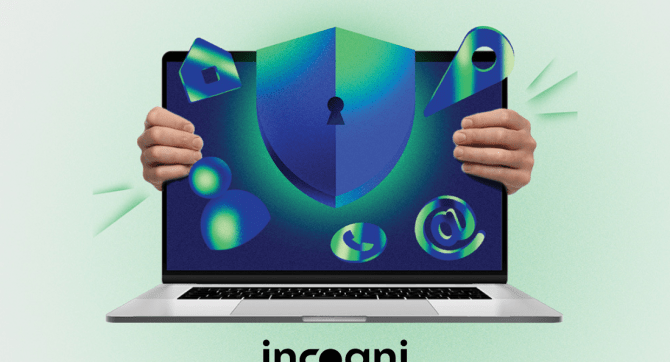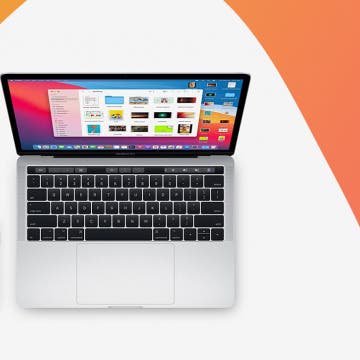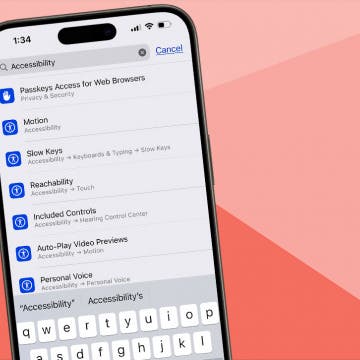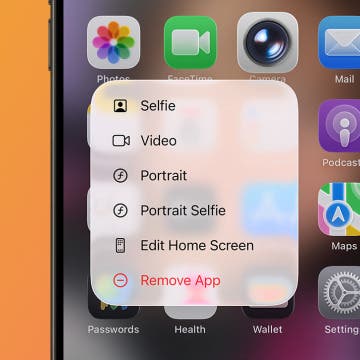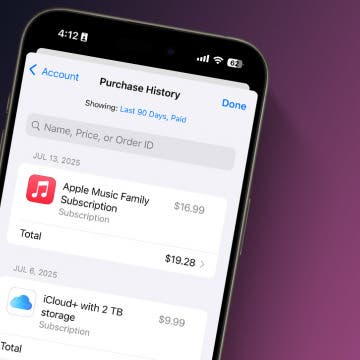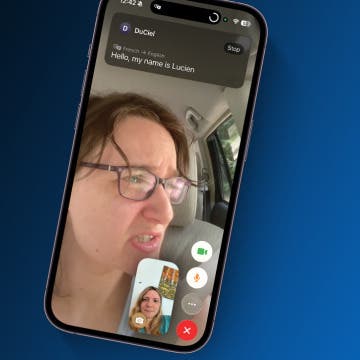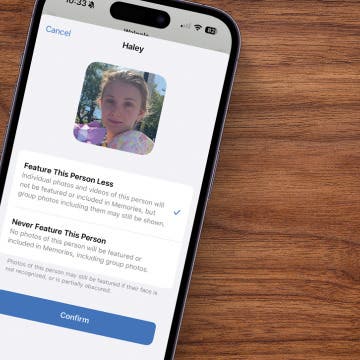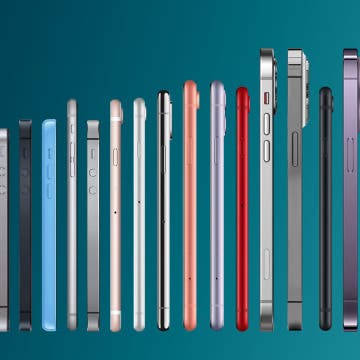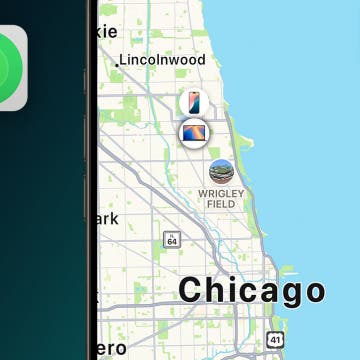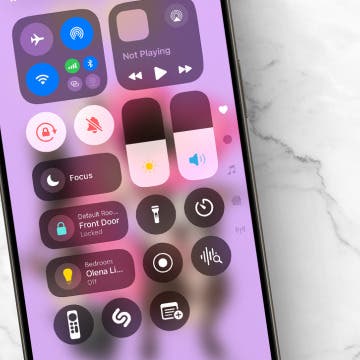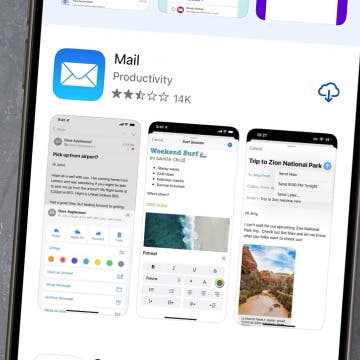The iPhone is an ideal platform for listening to online radio stations. In this article, I explain everything you’ll ever need to know about all this. You’ll learn how radio stations can be listened to on even non-jailbroken iPhones, without any hacks to play stations in the background; I also present a very thorough comparison of currently available third-party radio software.
First and foremost, let’s take a closer look at the built-in, out-of-the-box radio support.
1. Built-in capabilities: QuickTime
All versions of the iPhone (and, of course, the iPod Touch – from now on, I refer to all these as “iPhone”), under OS3, already have support for playing back some (not all!) possible radio stream types. What is more, you can do this in the background (assuming you start the playback from Safari) while doing anything else in the background (e.g., checking mail, running another(!), third-party Web browser etc.). They, however, don’t have any station lists built-in; therefore, you’ll need to use Safari to select any radio stations from online station lists. (After you’ve selected them, you can add them as Safari favorites; this means you won’t any more need to navigate to any online station lists to start playing them back. See section 1.1.4 Bookmarking streams in Safari for quick access for more info on this.)
1.1 Online, Web-based station link directories
All you need to do is firing up Safari, navigating to a Web page with either MP3 or AAC station lists (more on them later) and click these links.
You can find a lot of stations like these HERE (SHOUTcast; more on the different stream types and compatibility below), HERE (strictly MP3) or HERE (strictly AAC).
1.1.1 SHOUTcast
The first, http://yp.shoutcast.com/, is the official directory of SHOUTcast, of which the MP3 streams the iPhone is compatible with. All you need to do is tap the “Tune in!” icons in the beginning of a row to fire up QuickTime and start the playback. Note that several of the streams are AAC+, which the iPhone is incompatible with. That is, do NOT tap links that have AAC+ as the type (the last column in each row). To quickly hide all these (with QuickTime, non-working) streams, just tap the “Type” link in the top right of the station chart as can be seen in this screenshot; this will order the streams based on their type. As the ones with MP3 will be the first, you’ll be able to safely tap any of them and you won’t need to check their type any more.
(A technical note: as there’re dozens of screenshots in this roundup and the size of the text is well over 60 kbyte, I’ve chosen not to show you any of the images by default. That is, you’ll want to click the screenshot links in order to actually see these. Sorry for this – I think dumping 30-40 images on you would have made you angrier than this “only show really requested images” approach :) ).
1.1.2 xiph.org
The second, http://dir.xiph.org/by_format/MP3, and third, http://dir.xiph.org/by_format/AAC, is easier: you won’t need to filter for type as these two pages only contain stations already compatible with your phone. In addition, you can safely add these stations as Safari favorites (unlike with those of the above-shown SHOUTcast page); more on this later.
1.1.3 Moodio.fm
There are other, even more iPhone-friendly ways of getting to lists of radio stations. For example, if you register at http://www.moodio.fm and, then, from Safari, navigate to http://m.moodio.fm, you’ll gain access to an interface specifically tailored for mobile browsers, meaning far faster loading and quicker navigation. Unfortunately, Moodio has far less streams on offer than the above-mentioned three pages. Nevertheless, you may still want to use this service, particularly if you want to either reduce your data use (most MP3 streams broadcast at 128 kbps, which, when listened to over AAC, only take roughly the half, about 56 kbps data) or battery use (MP3’s may put somewhat more strain on the battery than AAC – more on this later).
A very important note: by default, Moodio.fm uses 24 kbps parametric stereo (that is, HE-AACv2) mode. QuickTime is unable to play this back (in stereo). That is, you will want to select a non-parametric stereo mode. To achieve the (comparatively) best audio quality, you’ll want to use the 56 kbps mode. To select another format, tap the link “Channel Bitrate/channel settings” and roll down the selector list to 56 kbps. Select it; tap Done and, on the Web page, Submit.
A screenshot of the mobile page is HERE.
Note that, as with the xiph.org links (see 1.1.2), you can directly add the station links to your Safari favorites to avoid having to navigate to http://m.moodio.fm every time you want to start listening to some tunes. I explain this all in the following section.
1.1.4 Bookmarking streams in Safari for quick access
It’s very easy to add direct stream URL’s in the bookmarks section of Safari. It can’t be done automatically or while adding the bookmark (Safari, unfortunately, only allows for editing the name but not the address of a Web page when you store it; this can be only done later, in a separate edit step); however, with some manual hacking, it’s actually very easy.
1. Tap-and-hold the link to the stream (PLS file etc.) In the dialog that comes up, select Copy.
2. Add a new favorite. It can be anything – for example, the current Web page, which is http://www.winmobiletech.com/radio.htm in this next screenshot
3. Edit this favorite – it’s only now that you can edit not only its name, but also the contents. Delete the old content and copy the URL you’ve copied to the clipboard in Bullet 1.
To Edit, go to Favorites and tap the Edit button. Scroll down to the newly-added favorite (here: Fav mp3 stream) (screenshot)
Tap it and tap the address (not the name) to edit it. Clean the field entirely and, then, just copy the address to it from the clipboard by tap-and-holding the (cleared) textfield and selecting Paste after it's displayed (screenshot)
The edited favotite will look, then, like this. Then, tap the Bookmarks arrow to take you back to the list of bookmarks; there, tap Done.
4. After this, you won’t even need to fire up these pages – you can directly select your favorite stream from inside Safari favorites. This also means it’ll be much faster and easier to switch between the streams.
Note that this won’t work with the streams available in the SHOUTcast directory (at http://yp.shoutcast.com/).
1.2 Problems with built-in QuickTime - why go for an external radio client at all?
While the built-in QuickTime has some definite advantages (no need to set up third-party apps; ability to play back in the background etc.), it has some major disadvantages too. Therefore, you’ll also want to check out third party offerings as well. Why? It’s easy:
- Almost all of them offer metadata support: with most (but not all) stations, you will see what is played back. With some players, you can even purchase the current song from the iTunes store right away; some even offer displaying the lyrics of the song etc.
- Built-in lists. No need to fire up Safari and wait for the station list to download: it’s available right when you start the app (with some exceptions: ooTunes always downloads it dynamically. However, navigating / searching it is still much faster than in a Web browser). This also means it's not in a Web browser that you need to navigate the station list, which would be pretty cumbersome on non-mobile-optimized lists as that of http://yp.shoutcast.com/.
- There are radio clients that not only support MP3 and AAC(-LC), the only two formats supported by QuickTime, but also WMA, OGG and HE-AACv2. WMA is very widely used throughout the world. For example, while most of the streams of BBC (mobile stream page HERE) use RealOne (a.k.a. RealAudio), it also has some WMA streams – but nothing else (no MP3 etc.). The streams of YLE (the Finnish broadcasting company) are WMA only. That is, most “big” state-funded broadcasters almost exclusively use WMA.
While OGG is only used by few stations (compared to the number of stations using other formats), it is still useful, particularly with stations only having MP3 as alternatives. It, in geneal, is broadcast at far lower speeds than the streams broadcast in MP3 (read: save data use and be able to stream over EDGE, as opposed to 3G) and, on the iPhone, playing back OGG streams is battery-friendlier than doing the same with MP3 streams. In addition, many (smaller) for example Finnish stations have either MP3 or OGG – but nothing else (no AAC-LC, WMA of HE-AACv2). In addition, there are stations that exclusively broadcast in OGG; for example, THIS stream (broadcast times listed HERE; the page uses EET timezone.)
HE-AACv2 is gaining popularity very fast because it only needs 24-32 kbps (as opposed to the 96-128 kbps of MP3, 38-64 kbps for OGG, 56-96 kbps for WMA and AAC-LC) to deliver almost flawless, stereo sound. This means you don’t even need to use the 2.75-generation EDGE to listen to these stations; even a plain GPRS connection will work. This is very good news for example for Vodafone users, which, in several countries, can only access either GPRS or 3G but no EDGE. Many small stations already use HE-AACv2.
- QuickTime doesn’t support recording. Some (at the time of writing, one, but some developers confirmed they will add recording to their apps) radio clients support even this. The importance of this is huge: if you listen to, say, an interesting interview or song, you can record it right away, without any quality loss.
- Time shifting: there may be cases you will want to rewind the stream to listen to, say, a sentence (or a whole interview) once again. With QuickTime, this isn’t possible; with some (currently, one; but, as with recording, several developers promised implementing time-shift) third-party apps, you can.
1.2.1 Playing in the background
Currently, there is a major problem with all (current – this will change in the future, see below) third party radio clients: they can’t play their stuff in the background, unlike QuickTime. With the latter, if you initiate playback from Safari (which can run in the background), if you press the Home button, the playback will go on and you’ll be able to switch to any other app (except for Safari, which brings up the QuickTime interface). If you do the same with any third-party radio players, they’ll immediately exit.
There are two solutions to this problem if you do want to stick to using third-party apps because of the above-explained advantage (for example, because the iPhone cannot play back OGG, HE-AACv2 or WMA streams at all or you absolutely must have access to the currently-playing song metadata): either jailbreaking and running Backgrounder or waiting for the developers to implement Safari invocation. In the following, I explain these two subjects at length.
1.2.1.1 Jailbreaking and running Backgrounder
The easiest and most general way of making third-party radio apps is jailbreaking your phone and installing Backgrounder from the Cydia repository.
Jailbreaking has been declared as illegal by Apple. However, being declared illegal doesn’t mean you’ll be jailed for “cracking” your phone. Let me cite THIS: “this is just a complaint in the copyright office, and Apple hasn't made any legal moves yet against anyone responsible for jailbreaking. As the Electronic Frontier Foundation states, it would be extremely hard for them to go after individual jailbreakers -- if you buy an iPhone, it should be your right to "get under the hood," as they say, and do what you want.” In order to jailbreak your OS3 phone, see THIS or my bullets 1…5 HERE, in the UPDATE (06/29/2009 3:23CET) section.
After jailbreaking and installing Backgrounder, all you need to tap and hold the Home button until “Backgrounding enabled” is displayed. If you, then, release home, the app suspends, but continues playing in the background. If you, then, tap its icon, you’ll return to the app. All subsequent Home presses will only send the app to the background, not exit it. To restore the default functionality, while in the app, tap-and-hold the Home button until “Backgrounding enabled” is displayed. Then, if you quickly release the Home button, it exits. (If you don’t release the Home button in, at most, 2-3 seconds after “Backgrounding [en/dis]abled” is displayed, the app won’t exit / be sent to the background. This functionality is useful for toggling between the two states to be absolutely sure you don’t accidentally exit the application if you don’t remember if you’ve previously enabled backgrounding for a given app.)
1.2.1.2 In-app support for background play
There’s another way for a developer (but not an end user – that is, only read on if you’re a developer working on radio clients for the iPhone!) to enable backround playback: by the help of Safari.
If you’ve ever used a third-party Web browser (you should; some of the better titles, particularly iCab Mobile, add a lot of missing functionality to the phone; please see THIS), you may know that almost all of them have an “Open [the current page] in Safari” feature, which lets you open the currently browsed page in Safari.
Radio client developers could do exactly the same: when the user wants to play back an MP3 or an AAC-LC stream, he or she can go for selecting QuickTime for playback via, say, a separate button or menu item. Then, behind the scenes, Safari is invoked with the address of the stream as a parameter. This will result in the immediate playback of the file in QuickTime – without having to do anything else. And, of course, you can already background he playback as it’s been initiated from the background-able Safari.
Of course,
- the user, then, won’t be able to use his or her Safari (not a big deal: an alternative Web browser like iCab Mobile will work just fine while Safari is busy playing back the stream in the background)
- there won’t be any metadata displayed in QuickTime (as opposed to the vast majority of radio apps) with any of the streams
- this will only allow for playing back MP3 and AAC-LC, and nothing else (OGG, HE-AACv2 or WMA).
Now that I’ve explained what needs to be done, I really hope radio app developers do implement this functionality – it’d be of GREAT help for no-jailbreak folks. Nevertheless, it’ll be at least a month from now (20th of July, 2009) that you’ll see radio apps like these. And, don’t forget: it’s really-really easy to jailbreak a phone; so is to install / use Backgrounder.
2. Preserving battery
Now that we’ve seen what kind of online stations the built-in QuickTime browser you can play back and what advantages and disadvantages it has compared to the alternative, third-party solutions, let’s take a look at how you can reduce the power usage when listening to online music. In this chapter, you’ll find a lot of highly useful tips and tricks, with which you can greatly (and I certainly meant this!) improve your battery life.
2.1 3G vs. 2.(7)5G vs. Wi-Fi
Whenever possible, deactivate 3G (if you have a second- or third-generation iPhone used in a compatible 3G network, that is). Why? It’s easy: I’ve made some very thorough experiments with power consumption when streaming over cellular (mobile phone) connections. For this, I’ve listened to a 31 kbps VBR HE-AACv2 stream in Pocket Tunes. I’ve measured the battery life decrease of 0.6%/minute when streaming in 3G and 0.3%/minute when doing the same in 2.75G (EDGE) and 2.5G (GPRS). This means streaming 3G consumes two times more battery than in 2.75G with a stream that, when streamed over Wi-Fi, consumes 0.18% power a minute.
This also means that, even if you have an unlimited Internet data plan, try using Wi-Fi whenever possible because it’s almost two times more battery-friendly than even 2.75G (EDGE) / 2.5G (GPRS) – and 3.3 (that is, 60/18) times more so compared to 3G.
Having to rely on pre-3G stream speeds means the following:
- If you only have GPRS connection (but not EDGE), select a station broadcasting at less than 35-40 kbps to avoid pauses and stuttering. You can easily see if your phone is in GPRS only: then, to the right of the name of your network, there is a circle and not the capital letter ‘E’ (it’s '3G' when in 3G mode and it’s here that the Wi-Fi signal is shown when operating over Wi-Fi.)
Note that, with some networks (for example, Vodafone in some? all? countries) there’s no EDGE at all. There, you either use 3G or GPRS. The latter rules out all stations with speeds over 40 kbps. If this is the case, you will most probably have to rely on HE-AACv2 (also known as AAC+) streams, should you want good audio quality and stereo sound. The other formats, MP3, AAC-LC (the two formats natively supported by the built-in QuickTime player) and WMA are completely unable to deliver good, stereo audio quality under 40 kbps; OGG is able, but around 36-38 kbps, which may result in stuttering over lower-quality GPRS connections or congested network.
You can find a lot of AAC+ streams at http://dir.xiph.org/by_format/AAC+ and http://yp.shoutcast.com/. Note that, with the latter, you will want to click radio stations with AAC+ type (see the last column). Unfortunately, unlike with collecting with MP3 stations only, you will not want to tap the header of the last, “Type” column, to order them to collect all AAC+ stations at the end of the list because it’s not possible to easily jump to the end of this list. (Tapping will only order the stations in a way that the list starts with MP3 ones; that is, stations well above 40 kbps - and the few that broadcast under 40kbps, do so with awful audio quality.)
Note that moodio.fm (which, as with the former two, stream directories, that is, xiph.org and shoutcast.com, has been introduced in section 1. Built-in capabilities: QuickTime), by default, also uses AAC+. As with the former two stations, in order to play back these AAC+ streams in an AAC+-capable radio player (the built-in QuickTime isn’t one of them) like Pocket Tunes Radio or FStream, you’ll want to copy these links to the clipboard and, then, paste them into a custom, user-defined station in these apps (as long as you don’t find a station of your liking in the built-in station directories of these radio clients). To do so,
1. in Safari, long-tap the link and, then, select “Copy” from the context menu
2. Switch to the radio station, go to its dedicated custom station entry dialog (with FStream, Favorites / Edit / Add new webradio at the bottom; with Pocket Tunes, Favorites / Edit / +) and tap the URL field a bit longer after cleaning it entirely (if there’s a http:// in it; with FStream, there isn’t). You’ll see a Paste flag (icon) as in this screenshot
3. Just tap it; the station URL will be pasted to the field
4. You can also give your station a name
(Note that you can also manipulate the favorite list of FStream via Wi-Fi, from a desktop Web browser. It offers a far faster way of adding and deleting favorites.)
Note that Pocket Tunes Radio also has a built-in Web browser. If you navigate from it to, say, m.moodio.fm or yp.shoutcast.com, you won’t need to do any copy / pasting like explained in the previous section. FStream (my other pick for HE-AACv2 playback) doesn’t have a Web browser. Note that several other (except for ooTunes, not that recommended) players also have a built-in browsers. You can do exactly the same in all of them except for eingrad’s RadioBOX, which, currently, has bugs in its Web browser: when you tap a link, the playback (if the built-in QuickTime is compatible with it) will start in QuickTime and not in the built-in player. (The developers stated they would fix this bug some time.)
2.2 Refrain from using direct A2DP – whenever possible, use dongles or wired headphones
With OS3, iPhone has – at last – received full A2DP (and partial AVRCP) support.
Unfortunately, as with most other mobile platforms, A2DP puts a considerable drain on batteries. I’ve vey thoroughly benchmarked the battery life when playing back a long local (that is, not streamed) podcast MP3 in the built-in iPod application using a wired and, then, a wireless (A2DP) headphone. The power consumption figures are 0.045%/min and 0.25%/min, respectively; that is, A2DP has resulted in a more than five-fold battery life usage – it added about 0.2%/min power usage. If you, for some reason (because your cellular operator doesn’t have EDGE support and you can’t use moodio.fm to transcode your station as it’s not listed in its comparatively restricted default station directory), must stream over 3G, the additional power usage won’t be that apparent. When streaming over 2.(7)5G or, even better, Wi-Fi, the impact on the battery life will be pretty much visible and easily more than two-fold over Wi-Fi (unless you play back a stream needing a lot of power to decode – for example, MP3 streams with song metadata).
Incidentally, don’t forget a lot of A2DP headphones are plain useless with the iPhone (unlike most other platforms) when the latter streams over Wi-Fi. (Please see my A2DP roundup for more info.) Only few models can be used together with iPhone when streaming over Wi-Fi. This, however, isn’t an issue when doing the same over cellular connections.
2.3 Select the right format – different power needed to decode different stream types
There are some differences in power usage between streams having song-related metadata info and streams without them. This is particularly true of MP3, where the difference of playing back a stream with metadata (over the most battery-friendly connection type; that is, Wi-Fi) can easily consume almost twice as much battery than doing the same with a stream without metadata. Some developers state this is because hardware acceleration / decoding can’t be used (that efficiently) with streams with metadata than ones without.
In addition, there are differences between different stream types. For example, on the iPhone 3G (all the tests have been conducted on the 3G; I’ll, however, repeat the tests as soon as I get a 3G s), playing back MP3 streams, in general, is the most resource-consuming. This means if you want to increase battery life, you’ll want to avoid MP3 streams.
According to my tests, OGG is (in some players, by far) the most battery-friendly format, followed by WMA (except for Wunder Radio, which has pretty heavy battery use with WMA). WMA is, then, closely followed by HE-AACv2 (except for Tuner2, which produced clearly higher power consumption than FStream and Pocket Tunes). The worst (most battery-consuming) format, in general (but not with all players) is MP3. The power consumption difference between OGG and MP3 (the best- and worst-behaving format) is roughly two times in all the, in this regard, tested, OGG-capable apps (FStream and Pocket Tunes Radio). That is, a rule of thumb is always trying to prefer OGG to all the other formats if, otherwise, the other factors (stream speed etc.) can be ignored.
Also, there are huge differences between the power use of radio clients streaming the same MP3 stream (other stream types aren’t as affected – for example, WMA streams are played back using almost the same power in all the tested, WMA-compatible clients). This is especially prevalent with the current (but not future - they've been fixed in this regard) ooTunes Radio, particularly with streams that have medatata. With them, it can easily consume (at times, considerably more) two times more power (when operated over Wi-Fi; over a cellular connection, particularly over 3G, the difference isn’t as pronounced) than all(!) the other players. Without metadata, the difference isn’t so pronounced; then, the biggest difference between it and the (at least with that stream type) results of the more battery-friendly apps was about two-fold.
In the comparison and feature chart, I very thoroughly elaborate on the power consumption of each client.
3. Current radio clients – a bird’s view
In this section, I provide you with a quick summary of each radio client in the order I recommend them (except for the first, built-in QuickTime – I list it in the chart as first so that you can easily compare it to the third-party offerings.)
Note that I couldn’t test SHOUTcast radio (a self-standing, free SHOUTcast client for the iPhone), which, for some reason, doesn’t seem to be present in the European AppStore. I sent them a mail some days ago – I still haven’t received any answer. I, nevertheless, don’t think it’s any better than ooTunes when it comes to e.g. metadata support or playing back MP3 / AAC streams in the background, passing Safari the direct link of the stream.
Also note that I haven’t reviewed local, in most cases, free radio apps tailored to receive a given station and nothing else. The reason for this is simple: these apps are, in general, really-really simple and lack any advanced features like built-in Web browsers or any way of even entering new streams, let alone goodies like recording or time-shifting. If all you want is listening to local stations (or stations from, say, a given town) and the lack of additional features isn’t a problem, just search for “radio” (or your country/town) in AppStore. Exactly this is why I haven't reviewed the (free and, when it comes to listening to arbitrary streams, pretty incapable) XM client either.
Finally, note that the last two apps reviewed below, Public Radio [Tuner] and ClickonRadio Pro, are not in the main chart. The sole reason for this is that they aren’t fully-fledged radio clients; therefore, it would have been useless to compare them to real ones.
3.1 Built-in QuickTime
We’ve already seen the pros and cons of using the built-in QuickTime in section “Problems with built-in QuickTime - why go for an external radio client at all?” Please refer to it for more information.
Screenshot: QuickTime playing back an MP3 stream. While the stream does have metadata, nothing is shown.
3.2 SourceMap’s FStream 1.0.4:
AppStore screenshot
I recommend this title the most as long as you don’t need a built-in Web browser (because you don’t want to do anything else with your iPhone while listening to radio or your phone is already jailbroken and you’ve also installed Backgrounder) or the excellent metadata features and huge station directory of ooTunes.
3.2.1 Screenshots
Some shots of the unique feature: recording broadcasts and, then, accessing them:
Naming your next record
List of records in storage (with local playback) and starting a new one
3.3 Oogli LLC’s ooTunes Radio 2.1:
This radio client, while its battery use at MP3 playback is clearly worse than that of the alternatives at the time of writing (but not in future versions - I've tested this myself!), has by far the best metadata support. Its Radio RooLette is really unique; so is its lyrics support. Also, the developer seems to be really enthusiastic and supportive – even in the (U.S.) AppStore, where he also answers questions. He’s also very fast at looking up streaming addresses: generally, if you asks him to add a stream gets it added (if it's compatible) within 24 hours. That is, you don't even know how to find the "stream" for many stations, just ask the developer to do find it for you and add it to the central directory.
AppStore screenshot
Note that, also thanks to my past bug reports and detailed comparisons to other, alternative players, the developer was able to fix the MP3 excess battery usage bug. I’ve already tested the fixed version and found it out to be behaving comparably to the alternative players. It’s still not known when it becomes available for the public; in the meantime, use 2.1 (particularly with metadata-enabled streams) with caution if battery life is of paramount importance. (This won’t be an issue with past-2.1 versions.)
3.3.1 Some screenshots of the unique features
The main “Just playing” context menu with tools like adding it to favorites or publishing the radio station you’re listening to on Twitter / Facebook.
The main interface while playing back a station with metadata info it has also found album art for. Check out the clarity and resolution of it – isn’t it great? The check marks on Lyrics and Buy show there’s lyrics found for the current song and it can also be purchased from the iTunes Store. The badge “8” on Similar shows it has found eight ooTunes / YouTube hits (from the same artist or even for the same song – this means you’ll be able to quickly find all the YouTube clips related to the song! All I can say it’s great!!)
The Lyrics view shows the lyrics found for the actual song (if any). It’s not synchronized, unlike some of the standalone players over competing mobile platforms (see THIS if interested in how Windows Mobile, Symbian and BlackBerry handles this – but strictly with standalone files. No radio clients on any of these platforms offer on-the-fly lyrics lookup based on song metadata.)
This is the “Similar” tab. As can be seen, two other songs have been found from the same artist – and six from others. If you tap any of them, you can select between ooTunes- and YouTube-based lookup. Here’s another “Similar” tab for another song (main interface shot HERE).
Two shots of the “Recent” tab HERE and HERE: it lists all the songs you listened to. If you tap any of these songs, their metadata will be looked up, meaning you’ll be able to, for example, search for it under “Similar”.
Finally, a shot of the really unique “Radio RooLette” (accessible from the main menu), which shows several songs being played over different streams. Just tap them to switch to the song. The higher the position, the more recently it has started playing. I can only list one problem with the list: you can't configure ooTunes not to include radio stations under a certain bitspeed (and, accordingly, quality). It's pretty annoying to tap a tune only to find out some seconds later it's being broadcast by a low-quality, say, 24 or 32 kbps MP3 station... Incidentally, this (the inability to set a lower threshold for stations the client is allowed to switch to) is also a problem with all current radio players that have any kind of "random" functionality.
An iLounge review of a previous version is HERE. Note that, as is also explained in the comment below the article, the app has received automatic metadata lookup capabilities and the ability to make the album art full screen in the meantime. Another (shorter) review is HERE.
3.3.2 Some other screenshots
When you select an OGG stream, you’ll see this – this also shows the OGG support is pretty much basic and it’s only usable (with 32 kbps streams at least) on the superfast 3G S - but not on previous models.
The (current) “add your own stream” interface is pretty much buried in the Web browser (I haven’t even found it without the help of the developer). A screenshot of the main interface AppStore; note that, instead of tapping the “Send” button on the HTML form, you’ll need to tap the Play button again (the fifth icon in the toolbar) to start playback immediately, without sharing the station with others.
3.3.3 Future plans
Note that, in the near future, ooTunes will receive a lot of goodies:
- Stream recording in compressed (!) format (as does Resco Radio on Windows Mobile – as opposed to FStream, which records uncompressed, which means taking up a lot of storage). Currently, to support pausing the stream (to be able to continue where you’ve left off), the compressed stream is already being recorded. There isn't an interface to get to them or save them. The developer emphasized he’ll add support for this.
- It’ll be able to pass AAC / MP3 streams to the built-in QuickTime for playback via Safari so that the playback can be put in the backgrounded without jailbreaking. This will very soon come; here’s a screenshot of a beta of the next version I’ve been given by the developer. It is already capable of doing this trick.
- It’s unlikely to receive HE-AACv2 support because of the high price ($1) of the pre-unit license, which would drive up the price considerably.
3.4 NormSoft’s Pocket Tunes Radio 5.2.2:
An all-in-one good-performer hold a bit back with the comparatively high price and the lack of the excellent metadata capabilities of ooTunes, the recording features of FStream and the excellent time-shifting capabilities of Time-Shift Radio. Nevertheless, it’s still a worthy application to check out, particularly if, for some reason, you dislike FStream but still need OGG or HE-AACv2 support (two formats ooTunes still doesn’t support) or want to have an app with a built-in, pretty decent Web browser.
AppStore screenshot
However, I would, first, check out FStream and ooTunes – they’re considerably cheaper (with FStream even free) and offer a lot more functionality (except for a built-in, decent Web browser and, with ooTunes, OGG or HE-AACv2 support).
A screenshot of the main interface showing it lacks dedicate metadata-related goodies like even album art, let alone searching for similar songs or displaying lyrics. All it can do, metadata-wise, is purchasing from iTunes Store.
3.5 Time-Shift Radio 1.3
AppStore shot
This application is unique in the respect that it’s able to store broadcast you've already listened to in memory, making it possible to pause playback and, then, continue it when you resume the playback. It even supports rewinding.
In Settings, you can set the amount of RAM memory set aside for the unique time shifting capability. As you can see, you can even give it 64 MByte of RAM, which means you can rewind 1-2 hours even with faster streams.
It’s a bit restricted when it comes to “exotic” stream types like OGG, WMA or HE-AACv2. It doesn’t at all support metadata and doesn’t have a built-in Web browser either; that is, you must jailbreak your phone if you do want to make it play in the background if you want to access the Web. Nevertheless, the developers do plan to release improved versions with added functionality; for example,
- An additional version with recording capabilities – but without pre-added radio station URLs (directories) to avoid copyright infringements.
- In the forthcoming version 1.5, they’ll support organizing favorites in that you allow for moving titles up/down as is the case with Tuner Internet Radio 1.41, Wunder Radio 1.7, SourceMap's FSream 1.0.4 and eingrad's RadioBOX 1.4.1
- They’ll have a built-in Web browser; also coming in version 1.5
- Metadata support will also be added in 1.5
- Twitter will be added in 1.6
- They will list the songs played on several stations at the same time (as in ooTunes - see "Radio RooLette")
- HE-AACv2, WMA and OGG support is planned for version 1.7.
- They, however, don’t plan to add lyrics support nor getting your location to offer local radio stations.
A screenshot of the main interface. Note the partially filled slider; it’s there that you can rewind to listen to previously broadcast audio.
3.6 eingrad’s RadioBOX 1.4.1
AppStore shot
This client doesn’t have any unique features (unlike ooTunes, Time-Shift Radio or FStream). It’s a typical client without outstanding features; its built-in Web browser isn’t as good as that of Pocket Tunes Radio (or, when it comes to multimedia links, any of the other Web browsers) either, mostly because RadioBOX doesn’t support playing back streams when tapped from inside the client. The developers stated they may fix this bug.
The developers don’t seem to want to add HE-AACv2 support (because of the prohibitive licensing cost). Stream recording or timeshifting is unlikely to be added because of copyright issues. They don’t plan adding lyrics or album art support either. OGG support may be added, so is Twitter and GPS / local station listing. They do want to improve the built-in Web browser (e.g., Landscape support).
A shot of the main interface showing there’s no for example album art
A shot of the built-in (not very capable) Web browser showing the main (default) page
It’s one of the very few applications that offer Web-based favorite management
3.7 Wunder Radio 1.7
AppStore shot
This radio client is pretty capable – for example, its station directory, according to my tests, is second best after that of ooTunes. It also has a pretty decent built-in Web browser. It doesn’t support Landscape, though – as opposed to the absolutely best radio client in this respect, Pocket Tunes Radio. It has some goodies not (yet) found in some of the (otherwise, more) recommended clients; for example, using localization (including GPS) to present you local stations. It seems to have an annoying bug: while it has no excess battery usage problems when playing back MP3 streams, the case is different with WMA streams, where, in general, it consumes about three times more battery. That is, if battery life is of tremendous importance, use some other client (for example, FStream or Pocket Tunes) to play back WMA streams.
A screenshot showing the main interface with the station logo (also functioning as a link to the homepage), other goodies and some other, similar stations.
If you tap the “change bit rate” option in the previous screenshot, you can select other bitrates (screenshot). This is pretty useful: you don’t need to manually find other bitrates in the directory if the current one is too slow (meaning bad quality) or too fast (for the current Internet connection or your limited data plan).
A screenshot showing Wunder Radio in action with a stream also having metadata. Note that there’s no for example album art or list of similar / related songs.
3.8 Tuner Internet Radio 1.41
AppStore shot
This client is pretty widely known. However, I don’t really recommend it – there’re much-much more polished and capable radio apps.
The main interface showing a stream with metadata - as you can see, it has no additional goodies (timeshifting, album art, lyrics, similar songs etc.)
The directory listing interface
3.9 Tuner2 Hi-Fi Radio 1.0.7
This is a HE-AACv2-only, pretty expensive client. The developers state its HE-AACv2 decoder is considerably better than "the rest". I'm not sure this claim is right. I'm, nervetheless, sure it consumes considerably more power than FStream and Pocket Tunes Radio.
AppStore shot
Some shots:
Main interface with metadata & album art.
When you press the asterisk (*) on the interface above, you get more info on the current stream.
The song / station-specific menu button on the top left allows you to do the usual stuff: twittering, saving the current title’s metadata and the time you’ve listened to it etc.
The saved metadata works pretty similar to how ooTunes does the same. The difference is that ooTunes does this automatically (see its history tab). Here, the manually saved list of three saved songs (that is, saved metadata for a tune) can be seen HERE; HERE and HERE are the results of the page. As you can see, unlike with the, in this regard, far superior ooTunes, you can’t for example search for radio stations currently broadcasting this song and you can’t search YouTube either.
Twitter the current song.
3.10 allRadio 1.0.1
AppStore shot
I can’t really recommend this title – the most recommended ones are way better in every respect.
A shot of the main interface – as you can see, it’s really barebone, not even song metadata is supported. The station directory isn’t much better either (screenshot; another shot of the “All” category): it’s one of the very few clients that don’t have station searching capabilities at all.
3.11 Public Radio [Player / Tuner] 2.0
This is a Public Radio Exchange (PRX) client, which, let me cite them, “is an online marketplace for distribution, review, and licensing of public radio programming. PRX is also a growing social network and community of listeners, producers, and stations collaborating to reshape public radio. The mission of PRX is to create more opportunities for diverse programming of exceptional quality, interest, and importance to reach more listeners.” This means sometimes pretty interesting programs and podcast-alike downloads of past ones – but not being a “real” radio client. That is, you can only listen to pre-programmed PRX stations (and past programs), not arbitrary, user-defined ones.
AppStore shot of the just-released, new version
…and that of the real AppStore record
Some example screenshots:
Main page of a station with the current and the next program
An example of "Today's schedule" (the link at the bottom in the previous screenshot)
An example of the program description and the available past broadcasts of the same program
Another example of another program
3.12 ClickonRadio Pro
This radio client only lists local stations - that is, it doesn't have a full searchable list of stations. It seems it only has American stations - that is, it's not exactly meant for European / Asian etc. users. Otherwise, it has some decent features like displaying lyrics, YouTube search and listing songs played in the past two hours. It also has a “lite” version, which I haven’t tested so I don’t know in what ways it is restricted.
AppStore record
A station list of the developers' hometown - as you can see (see e.g. the scrollbar height), few stations are listed
A channel with the currently playing song and ones played in the past two hours
Information on an individual song (if you tap it in the previous screenshot) - FIRST, SECOND; listing the YouTube occurrences (invoked by the "watch YouTube videos" in the previous dialog)
Another song - in this case, with lyrics
...and here's the lyrics
END OF PART ONE – THE ARTICLE CONTINUES HERE (click the link!)
UPDATE (08/25/2009):
- Totally revised buffering code (should never have silence when the screen doesn't show "buffering".)
- Search is now done on the server (no downloading huge lists, etc.)
- Settings are now in the app itself (and still in the "Settings" app).
- Moveable tabs for the bottom of the "now playing" screen.
- Added the ability to "play in background" using Safari
- Hugely improved OGG Vorbis stream playback.
- Added a toggle setting for "timeshifting" (may improve battery life further to turn it off).
- Improved accessibility (voice over labels) for the "now playing" screen.
- No "do you want to play in safari" message for "DRM" tracks, now it just goes to it (since there's no other way to play them).
- fixed several crashes
- Now uses the built in mail functionality for sending feedback. (goodbye ugly webform!)
- Ability to upload the log from the now playing screen
- Search button on now playing screen
- Go to bookmarks from the "heart" icon on the front.
- Stop button in web browser (stops a loading page).
- Fix the automatic finding the stream from Sirius.
- Can now bookmark tracks from your ooTunes server (and play them back later from that area, if you are logged in of course)
- Bitrate display value from some streams (real audio streams in particular) now more accurate.
- Option to have the audio stop or pause when your headphones come unplugged (save you some embarrassment when listening to milli vanilli in public and your dancing gets out of control)
- Option for shake to stop/start playback.
- Tabs for Movies and TV Shows are now different (though this will take a server update to work again).
2.)
Nevertheless, don't forget that you can manually add any stations (including those of BBC) to any radio clients. It, surely, requires some work.
Some screenshots of these:


ooTunes (again, as with all the other screenshots, check out the scrollbar’s height):

two shots of WunderRadio:


FStreamer:


3.) A newly-released, free(!) AppStore app “Streamer




